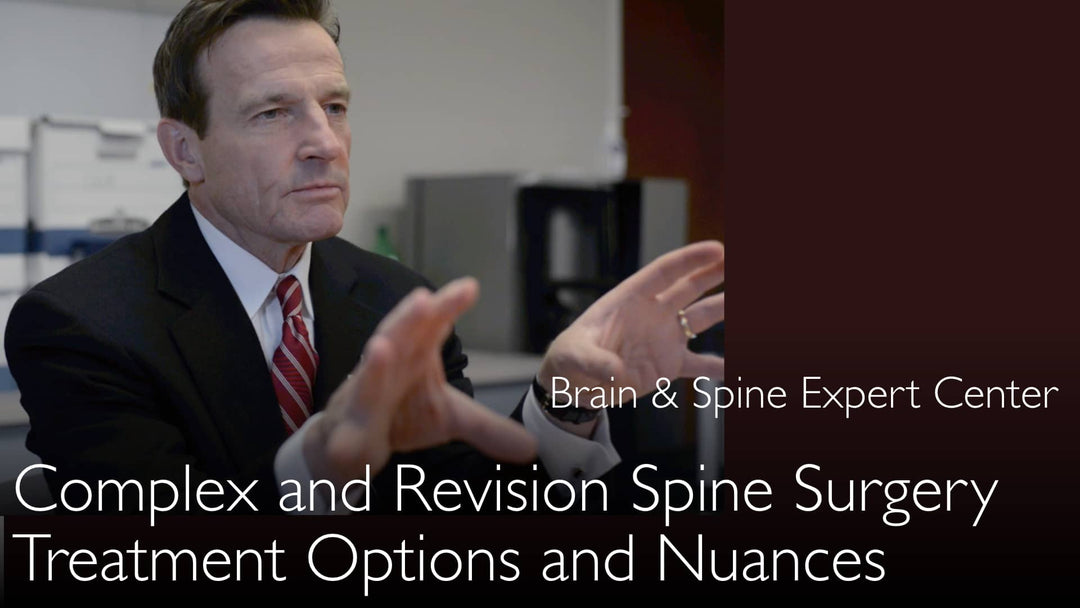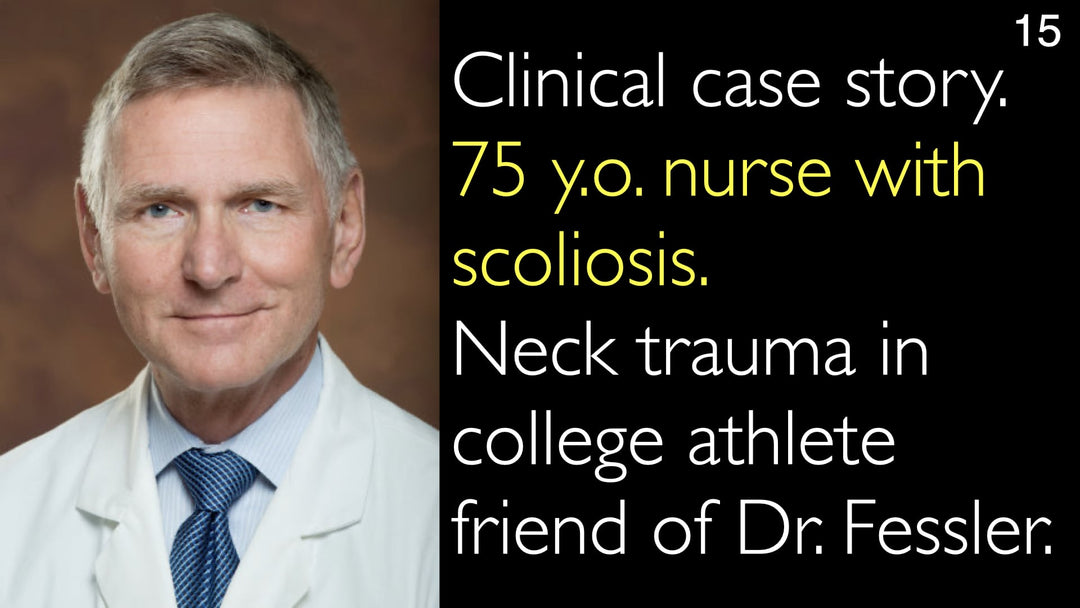Leading expert in complex spine surgery, Dr. Eric Woodard, MD, explains the intricacies of revision spine procedures. He details how ongoing spinal degeneration can necessitate further surgery after an initial fusion. Dr. Eric Woodard, MD, emphasizes the critical importance of achieving proper sagittal balance to prevent future revisions. A medical second opinion is vital for confirming a diagnosis of failed lumbar fusion. This process helps patients choose the best treatment option for their specific situation.
Revision Spine Surgery: Indications, Techniques, and Avoiding Complications
Jump To Section
- Revision Spine Surgery Overview
- Indications for Revision Surgery
- Technical Challenges and Scar Tissue
- Importance of Sagittal Balance
- Role of Medical Second Opinion
- Full Transcript
Revision Spine Surgery Overview
Revision spine surgery is a complex procedure often required after an initial spinal fusion. Dr. Eric Woodard, MD, a leading spine neurosurgeon, explains that the spine continues to age and degenerate even after successful treatment of one section. This ongoing process means that a significant number of patients may require additional intervention. Dr. Eric Woodard, MD, notes that perhaps as high as 20% to 25% of patients will need revision spine surgery within ten years after a lumbar fusion.
Indications for Revision Surgery
The reasons for pursuing complex revision spine surgery are similar to the initial indications for any spinal procedure. Dr. Eric Woodard, MD, states that key indicators include the development of progressive neurological weakness. Bowel and bladder dysfunction is another critical red flag that may necessitate surgical evaluation. Furthermore, a failure of conservative therapy to manage pain and other symptoms is a major consideration for surgeons like Dr. Woodard when assessing a patient for a revision operation.
Technical Challenges and Scar Tissue
Revision spine surgery presents unique technical hurdles that make it more difficult than a first-time operation. Dr. Eric Woodard, MD, highlights the presence of extensive scar tissue as a primary challenge. This scar tissue must be meticulously dissected away from delicate neural structures, increasing the complexity and risk. The presence of prior hardware or a fusion mass that may need to be removed or worked around adds another layer of difficulty for the surgical team.
Importance of Sagittal Balance
A critical factor in preventing the need for future revision spine surgery is achieving proper sagittal balance. Dr. Eric Woodard, MD, describes this as the nice balance of the torso over the pelvis in an upright posture. A common disorder seen in revision cases, especially in the elderly, is the flattening of the lumbar lordosis, causing patients to bend forward. To correct this, surgeons must often put more curve into the lumbar spine, sometimes requiring osteotomies to break and reposition the spine.
Role of Medical Second Opinion
Seeking a medical second opinion is a crucial step for any patient considering revision spine surgery. Dr. Anton Titov, MD, discusses this with Dr. Woodard, emphasizing its value in confirming a diagnosis of failed lumbar fusion. An expert second opinion from an experienced senior spine surgeon helps ensure the treatment plan is the best possible option. This process provides patients with confidence and a brighter outlook on their potential for a successful outcome from complex spinal hardware revisions.
Full Transcript
Revision spine surgery requires getting a medical second opinion. Revision spine surgery is often more extensive than the first spinal surgery. The surgeon has to weigh the indication for revision spine surgery very carefully.
A leading Boston-based spine surgeon shares his method for evaluation of patients for revision spine surgery, failed lumbar fusion, and complex instrumentation. Revision spine surgery medical second opinion: in 25% of cases, spinal fusion revision surgery is required within ten years after a lumbar fusion due to ongoing degenerative changes in the lumbar spine.
Video interview with a leading expert in spine surgery. Revision spine surgery medical second opinion helps patients avoid unnecessary surgical operations. Advice on revision surgery for failed fusion has to be tailored to the specific patient situation.
Medical second opinion clarifies the failed lumbar fusion diagnosis. It also helps to choose the best treatment for complex spine surgery and spinal fusion revision. Seek a medical second opinion on lumbar revision surgery and be confident that your treatment is the best.
There is a brighter outlook on spinal revision surgery and complex spine hardware revisions today. How long does a spinal fusion last? Approximately 10 years, as the spine continues to age.
Revision spine surgery medical second opinion can only be provided by an experienced senior spine surgeon. Complications of revision spinal surgery include failed fusion, which requires a repeat surgical operation.
Indications for complex revision surgery are progressive weakness, bowel and bladder dysfunction, or failure of conservative therapy. The surgeon has additional considerations in revision spine surgery because a lot of scar tissue is present.
It is very important to put more curve into the lumbar spine. Surgeons learned that balance of the torso over the pelvis is a crucial factor in preventing revision spine surgery. Revision spine surgery medical second opinion makes treatment decisions easier and better.
Dr. Anton Titov, MD: You perform a lot of complex spine surgery. Frequently, this involves multiple revisions and a lot of hardware placement. Could you please give some examples of the complex spine surgery that you do in your practice?
How should patients approach the situation of complex and revision spinal surgery?
Dr. Eric Woodard, MD: Sure. Spine surgery in general has a bit of a negative reputation as requiring more surgery. The reasons for that are numerous, but one of the reasons that is underappreciated is this fact: with the aging process, the spine continues to age and continues to change.
Even if one section of the spine is treated appropriately, other sections continue to age. They continue to break down. Not infrequently, perhaps even as high as 20% to 25% of the time, within ten years after a lumbar fusion, there will be a requirement for additional treatment.
It is due to the ongoing, age-related changes in the lumbar spine. Revision spine surgery is a bit more difficult than initial spine surgery because scar is present, and because of the presence of perhaps even prior fusion mass or prior instrumentation that has to be removed.
The scar needs to be dissected from the very delicate neural structures. Revision spine surgery is a bit of a different endeavor than the first time around. That is what makes revision spine surgery technically a bit more of a challenge from a surgeon's perspective.
The indications to do complex revision spine surgery obviously are similar to the initial indications for spine surgery. Indications are progressive weakness, bowel and bladder problems, or failure of conservative therapy.
But as I said, from a technical surgery standpoint, I have certain additional considerations in revision spine surgery, mainly due to the scar. Increasingly, we are seeing a particular disorder that is much more commonly seen in revision back surgery.
This disorder happens especially in the elderly: that is flattening of the lumbar lordosis. Patients tend to progressively come forward; patients bend forward. Some of that is a normal age-related process, spinal disc settling.
Some flattening of lumbar lordosis is due to surgery being limited. Another reason is when the surgery does not adequately restore what we call sagittal balance. Sagittal balance is a nice, balanced upright posture.
Increasingly with revision spine surgery, we are having to put more curve into the lumbar spine. We do this via a number of techniques. Sometimes the spine has to be broken in certain areas to reposition the spine in a balanced position.
Increasingly in the last 10 years, we have learned that balance of the torso over the pelvis is probably the most important element in preventing revision spine surgery.
Dr. Anton Titov, MD: How often do complications develop? How to treat failed spine fusion?







